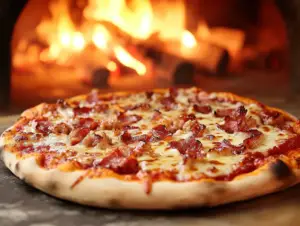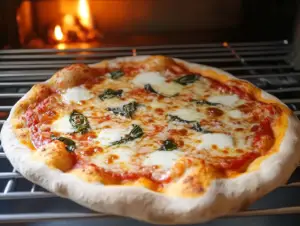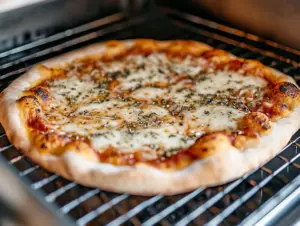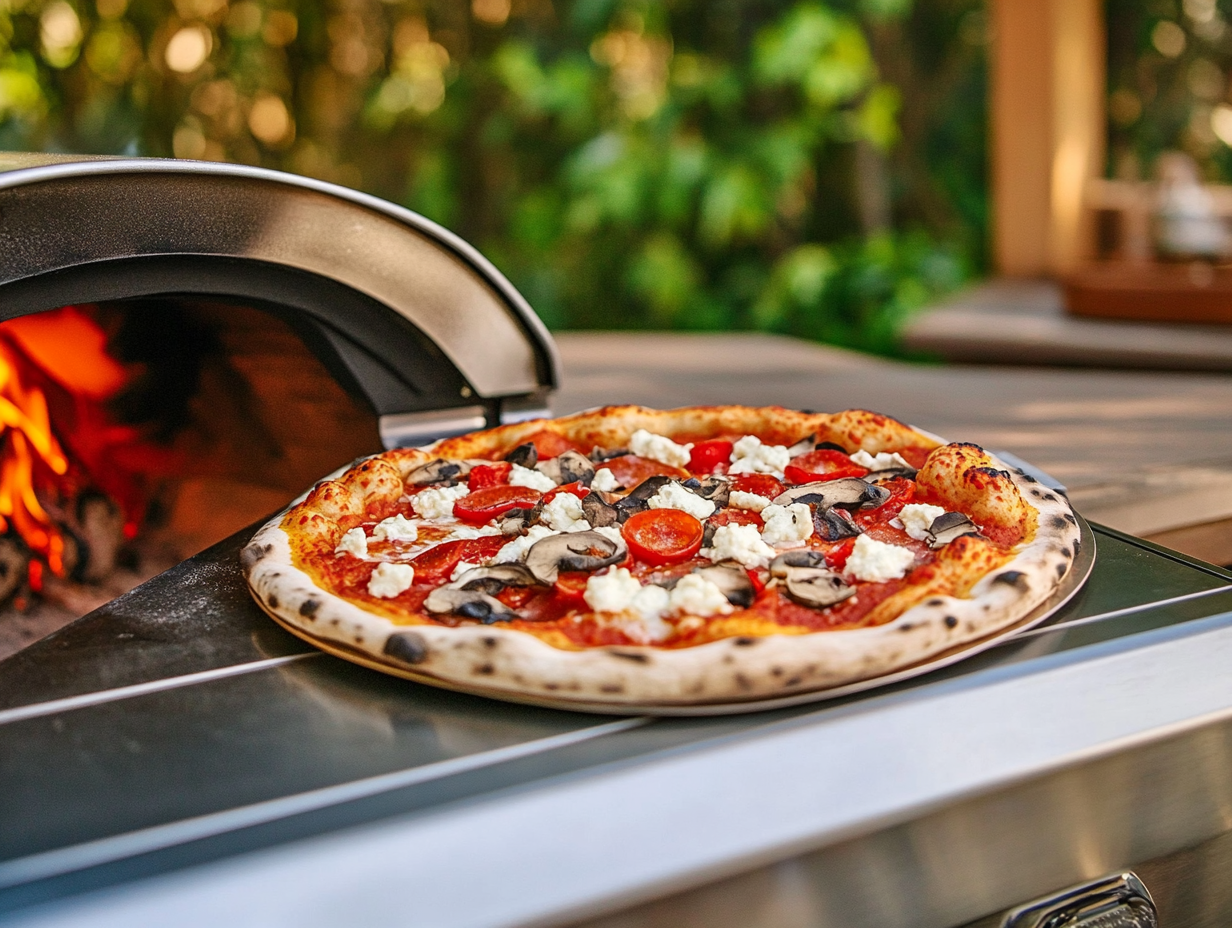Pizza is a universal favorite, and getting that perfectly crisp yet soft crust is every home cook’s dream. The secret behind a great pizza lies not just in the ingredients or dough, but also in the oven’s temperature. So, what is the ideal temperature for a pizza oven? This guide explores the science behind oven temperatures and how they influence pizza outcomes.
Understanding the nuances of pizza oven temperature will allow you to craft a perfect pizza, whether you’re aiming for a traditional Neapolitan style or a more American take. With pizza ovens ranging from wood-fired to gas, each type of oven requires specific heat levels to get the most out of your pizza.
Why is Oven Temperature So Important?
The oven temperature determines how quickly the dough cooks, how evenly it bakes, and whether your toppings melt without burning. While different pizza styles have slightly varied temperature needs, wood-fired pizza ovens tend to reach the highest temperatures, creating that perfect, charred pizza crust.
Understanding how to maintain the right temperature is key, and it can vary depending on the style of pizza you’re aiming for. For instance, Neapolitan pizzas are known for their light, airy texture, which is best achieved by cooking at higher temperatures—typically between 800°F and 900°F (430°C-482°C). Meanwhile, if you’re baking a New York-style pizza, a temperature range of 500°F-600°F may suffice for the thinner, crispier crust. Read more about how to get the perfect pizza using a stone or steel and why they make a difference.
When you’re using an oven, consistency is vital. For home bakers working with regular ovens, reaching professional-level heat can be tricky. But using tools like a pizza stone or pizza steel can enhance heat retention and distribution. Check out this guide on using infrared thermometers to monitor temperature accurately.
What Temperature is Ideal for Different Pizza Styles?
Each pizza style requires a specific temperature to ensure that the dough rises perfectly, the toppings cook evenly, and the crust achieves the desired texture. Here’s a breakdown of the recommended oven temperatures for different styles:
Neapolitan Pizza (800°F – 900°F / 430°C – 482°C)

- Cooking time: 60-90 seconds.
- Best for: Thin, airy crusts with leopard-spot charring.
- Description: Neapolitan pizza is the pinnacle of traditional Italian pizza-making. This style benefits from the extreme heat that comes from wood-fired ovens, where pizzas cook within 60-90 seconds. The high temperature results in the iconic charred spots on the crust without over-drying the interior.Tip: To achieve a Neapolitan-style pizza at home, you’ll need to use a pizza stone and crank up the heat in your home oven as high as possible, typically 500°F or more. A pizza steel can further enhance the crispiness of the base by transferring more heat to the dough.
New York-Style Pizza (500°F – 600°F / 260°C – 316°C)
- Cooking time: 7-10 minutes.
- Best for: Foldable, thin-crust pizzas with a balance of chew and crispiness.
- Description: New York-style pizzas have a thinner base but are cooked at lower temperatures than Neapolitan pizza. The longer cooking time allows the crust to firm up without burning the toppings. Typically baked at 500°F to 600°F, this pizza has a slightly longer cooking time but achieves a crunchier crust.
Chicago Deep-Dish Pizza (450°F – 500°F / 230°C – 260°C)
- Cooking time: 20-30 minutes.
- Best for: Thick, buttery crust with layers of cheese and toppings.
- Description: Chicago-style pizzas take a different approach. With a focus on a buttery, thick crust that holds multiple layers of cheese and sauce, the ideal temperature for this pizza style is lower to ensure the dough is fully cooked without burning. A 450°F-500°F oven is perfect for achieving the right consistency in a deep-dish pizza.
Measuring Oven Temperature Accurately
If you’re serious about pizza-making, especially in a wood-fired oven, you’ll need to ensure that the oven reaches and maintains the correct temperature. The most accurate way to measure the temperature of your pizza oven is with an infrared thermometer. This tool allows you to measure the surface temperature of the oven floor, ensuring that you’re cooking at optimal conditions.
There are two main types of thermometers you can use:
- Infrared Thermometers: These are non-contact tools that measure the heat on the surface of the pizza stone or oven floor. Simply point the thermometer at the center of the oven to get an accurate reading.
- Thermocouple Thermometers: These contact thermometers measure the air temperature inside the oven.
Learn more about the best infrared thermometers for pizza ovens.
Preheating Your Oven
To achieve the ideal pizza oven temperature, you must preheat your oven properly. Whether you’re using a wood-fired oven, a gas oven, or a home oven with a pizza stone, preheating ensures the oven is evenly heated. For Neapolitan pizza, aim for at least 30 minutes to an hour of preheating to ensure the stone is hot enough to crisp the crust within 90 seconds.
Heat Retention Tools
Using heat retention tools like a pizza stone or pizza steel can significantly enhance the quality of your homemade pizzas. These materials help distribute heat more evenly and retain heat longer, allowing for better crust development. Both stones and steels should be preheated for about 45 minutes to an hour at the highest temperature possible.
- Pizza Stone: Typically made from ceramic, pizza stones provide an excellent surface for retaining and transferring heat. They’re perfect for achieving a crispy crust in home ovens.
- Pizza Steel: A step up from a pizza stone, steel conducts heat more efficiently and can create the closest experience to a wood-fired pizza in a home setting.
Maintaining the Ideal Temperature in Wood-Fired Ovens
Maintaining the right temperature in a wood-fired pizza oven can be a bit tricky, as these ovens require regular fire management. The key is to start with small logs to build the fire gradually, then add larger logs to sustain the heat.
Tips for Maintaining Heat in a Wood-Fired Oven:
- Use kiln-dried wood: Moist wood can lower the oven temperature and create inconsistent heat.
- Build your fire in stages: Start with small pieces of wood to establish the fire, then add larger logs as the oven heats.
- Measure the temperature regularly: An infrared thermometer is essential for checking both the surface and air temperature in the oven.
If you’re cooking multiple pizzas, it’s important to allow the oven to come back to temperature between each pizza. After each pizza, leave the oven for a few minutes to stabilize before adding the next one. You’ll also need to rotate your pizzas to ensure even cooking, as wood-fired ovens often have hot spots where the flames are strongest.
Troubleshooting Common Pizza Oven Issues

Even with a good understanding of the ideal pizza oven temperature, you might still encounter issues. Here’s how to troubleshoot some common problems:
- Pizza is burnt on the bottom but undercooked on top: This typically happens when the oven floor is too hot. Before cooking the pizza, wait a few minutes after pushing the fire to the back to allow the surface temperature to drop slightly.
- Pizza is undercooked in the center: This issue can occur if the oven temperature is too low or if the pizza is too large for the oven’s heat to penetrate evenly. Increasing the temperature slightly or reducing the pizza size can solve this problem.
- Inconsistent crust cooking: Uneven cooking is often due to improper rotation. Be sure to rotate the pizza every 30 seconds in a wood-fired oven to ensure all sides cook evenly.
FAQs
What is the Ideal Temperature for a Wood-Fired Pizza Oven?
For most wood-fired pizzas, especially Neapolitan-style, the ideal temperature is between 800°F and 900°F. This high temperature ensures that the pizza cooks in under 90 seconds, which is essential for achieving the characteristic charred spots on the crust without over-drying the center.
Can I Use a Regular Oven to Make Pizza?
Yes, though home ovens typically max out at 500°F to 550°F. To achieve the best results, use a pizza stone or pizza steel and preheat it for at least 45 minutes before cooking. This will help mimic the high-heat environment of a professional pizza oven.
How Long Should I Preheat a Pizza Oven?
For both wood-fired and home ovens, preheating is essential. Preheat for at least 30 minutes in a wood-fired oven, and up to an hour for home ovens using a pizza stone or pizza steel. This ensures even heat distribution and prevents the pizza from sticking.
Conclusion
Understanding# What is the Ideal Temperature for a Pizza Oven?
When it comes to making pizza, oven temperature is one of the most important factors in achieving that perfect balance between crispy crust and melted toppings. Whether you’re using a wood-fired oven, a gas oven, or a conventional home oven, understanding the correct heat settings for different types of pizza will dramatically improve your results.
This article explores the ideal temperatures for different pizza styles, tips for maintaining heat, common mistakes, and ways to troubleshoot temperature issues. We’ll also delve into the best practices for measuring and controlling pizza oven temperature, especially if you’re working with different oven types.
Why Oven Temperature Matters
The heat inside your oven affects how the dough rises, how quickly it cooks, and how the toppings melt and combine. Too hot, and you risk burning the crust before the toppings have time to cook. Too cold, and the dough may not cook through, leaving you with a soggy base and unevenly melted cheese.
For a perfect pizza, it’s important to find that sweet spot, which varies depending on the type of pizza you’re making. Neapolitan pizza, for example, requires a significantly higher temperature than a New York-style or deep-dish pizza.
Using a pizza stone or pizza steel in your home oven can help simulate the high heat of a professional pizza oven by retaining and distributing heat evenly. Find out more about how pizza stones enhance your baking.
Different Pizza Styles and Their Ideal Oven Temperatures
Each type of pizza has a specific temperature range that works best for it. Here’s a quick guide to the most popular styles and the heat they need:
Neapolitan Pizza (800°F to 900°F / 430°C to 482°C)
- Cooking Time: 60–90 seconds.
- Description: Neapolitan pizza is renowned for its thin, soft, and slightly charred crust. It requires an extremely high temperature, typical of a wood-fired oven, to cook the dough in under 90 seconds while achieving the signature charred spots on the crust.
- Tip: Using a pizza steel can help you reach higher temperatures in a home oven, allowing you to get closer to a Neapolitan pizza style. Here’s more on pizza steels and how they improve pizza baking.
New York-Style Pizza (500°F to 600°F / 260°C to 316°C)
- Cooking Time: 7–10 minutes.
- Description: Known for its thin but chewy crust, New York-style pizza is baked at a lower temperature than Neapolitan pizza, resulting in a longer cooking time. The slightly lower heat allows the dough to cook evenly, without burning the edges.
Chicago Deep-Dish Pizza (450°F to 500°F / 230°C to 260°C)
- Cooking Time: 20–30 minutes.
- Description: Chicago-style pizza, with its thick crust and layers of cheese and sauce, needs a lower cooking temperature to ensure the dough is fully cooked without burning the crust. A longer cook time allows the ingredients to bake evenly without overheating the outer edges.
Measuring and Maintaining the Ideal Pizza Oven Temperature

Achieving and maintaining the right temperature in your pizza oven is crucial, especially when cooking multiple pizzas. For wood-fired ovens, keeping the heat steady can be challenging due to the nature of the fire, but with practice and the right tools, it becomes easier.
How to Measure Oven Temperature
- Infrared Thermometer: The most accurate way to measure the temperature inside your oven, especially the surface temperature of the pizza stone or floor of the oven, is by using an infrared thermometer. This type of thermometer gives you an instant reading without direct contact.
- Thermocouple Thermometer: This tool measures air temperature inside the oven and can be used alongside an infrared thermometer for more precise heat control.
- Tip: Check out these guides on the best pizza oven thermometers available for both home and professional use.
Preheating Your Oven
Preheating your pizza oven is essential, whether it’s wood-fired, gas, or electric. You want to make sure that both the air and the surface inside the oven are heated evenly before you start cooking.
- Wood-fired ovens: It can take up to 1 hour for a wood-fired pizza oven to reach its peak temperature. Start your fire with small pieces of wood and add more as the oven heats up.
- Gas ovens: These heat up more quickly but can still take 30-45 minutes to reach optimal temperature.
- Home ovens: Preheat for at least 45 minutes if using a pizza stone or steel.
Maintaining Consistent Temperature in a Wood-Fired Oven
Maintaining the right temperature in a wood-fired oven can be tricky since these ovens are powered by real fire, which fluctuates depending on how well the fire is managed. Here are some tips for keeping the heat stable:
- Use dry wood: Kiln-dried wood burns more consistently and at higher temperatures than wet or green wood.
- Start small: Build your fire gradually, beginning with small kindling to get the flames going before adding larger logs.
- Monitor constantly: Use an infrared thermometer to check the temperature every few minutes, ensuring the heat stays within the ideal range.
Troubleshooting Heat Issues
- Too hot? Move the fire to one side of the oven to reduce the surface temperature, or wait a few minutes before adding more fuel.
- Too cold? Add small pieces of wood to boost the heat quickly, but avoid overloading the oven with large logs that can smother the flames.
Common Pizza Oven Temperature Mistakes
Even with the best tools and tips, mistakes can happen. Here are a few common pitfalls to avoid when working with pizza ovens:
- Not preheating enough: One of the most common mistakes is not giving your oven enough time to preheat. This results in uneven cooking, especially for thicker pizzas.
- Using the wrong oven setting: Many home ovens come with a convection setting, which can disrupt the ideal baking conditions for pizza. Stick with the traditional bake setting and rotate your pizza halfway through cooking to ensure even heat distribution.
- Ignoring hot spots: Wood-fired ovens often have areas that are much hotter than others, so it’s important to rotate your pizza regularly to avoid burnt edges or an undercooked center.
FAQs About Pizza Oven Temperatures
What’s the Best Temperature for Neapolitan Pizza?
For a classic Neapolitan pizza, the ideal oven temperature is between 800°F and 900°F. This extreme heat allows the pizza to cook in under 90 seconds, giving it the signature charred yet soft crust.
Can I Make Pizza in a Regular Home Oven?
Yes, though home ovens typically max out at 500°F to 550°F. To improve the results, use a pizza stone or pizza steel to replicate the high temperatures of a wood-fired oven.
How Long Should I Preheat My Oven?
You should preheat your pizza oven for at least 30 minutes. For home ovens using a pizza stone or pizza steel, preheat for up to an hour to ensure the stone reaches the right temperature.
Conclusion
Understanding the ideal pizza oven temperature is key to creating the perfect pizza. From the high heat of a wood-fired oven for Neapolitan pizza to the moderate heat needed for a New York-style pizza, getting the temperature right makes all the difference.
Whether you’re using a wood-fired, gas, or home oven, tools like infrared thermometers and pizza stones can help maintain consistent heat and improve your baking results. Keep experimenting and fine-tuning your technique, and soon you’ll be making pizzas that rival your favorite pizzeria.
For more on using the best tools and techniques to achieve pizza perfection, visit how to use a pizza stone and best pizza oven thermometers.

